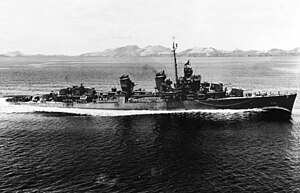| Battle of Cape St. George | |||||||
|---|---|---|---|---|---|---|---|
| Part of the Pacific Theater of World War II | |||||||
 U.S. destroyer Charles Ausburne operating in the Solomon Islands around 1943. | |||||||
| |||||||
| Belligerents | |||||||
|
|
| ||||||
| Commanders and leaders | |||||||
| Arleigh Burke | Kiyoto Kagawa† | ||||||
| Strength | |||||||
| 5 destroyers | 5 destroyers | ||||||
| Casualties and losses | |||||||
| None |
3 destroyers sunk, 647 killed[1] | ||||||
The Battle of Cape St. George was a naval battle of the Pacific campaign of World War II fought on 25 November 1943, between Cape St. George, New Ireland, and Buka Island (now part of the North Solomons Province in Papua New Guinea). It was the last engagement of surface ships in the Solomon Islands campaign.
Background[]
Americans had landed troops on Bougainville on 1 November 1943. This posed a threat to the Japanese base on Buka Island to the north, and 900 Japanese Army troops were loaded on the destroyer-transports Amagiri, Yugiri and Uzuki and were sent, escorted by the destroyers Onami and Makinami under the command of Captain Kiyoto Kagawa, to reinforce the garrison.
The United States Navy learned of the convoy and sent the five Fletcher-class destroyers Charles Ausburne, Claxton, Dyson, Converse, and Spence—under the command of Captain Arleigh Burke—to intercept it.
Battle[]
The Japanese destroyers landed the 900 troops and supplies, embarked an equivalent number of Navy personnel (that the Army troops replaced), and were returning to Rabaul when at about 01:40 they were spotted on radar by the U.S. warships. Superior radar allowed the American ships to approach and launch their torpedoes at about 01:55 before the Japanese sighted them. Onami was hit by several torpedoes and sank immediately. Makinami was hit by one torpedo, disabled, and then sunk by gunfire. The transport destroyers fled in different directions; Burke pursued Yuguri and after a long stern chase sank her about 03:00; Uzuki was also hit but escaped with severe damage.[2]
Aftermath[]
The battle marked the end of the Tokyo Express and the end of Japanese resistance in the Solomon Islands, and the success of Allied efforts to achieve superiority in night combat using radar. There were no more surface engagements in the Pacific War until the Mariana and Palau Islands campaign began with the invasion of Saipan in June 1944.
Namesake[]
The U.S. Navy Ticonderoga-class guided-missile cruiser USS Cape St. George (CG-71), in commission since 1993, was named for this battle.
See also[]
Notes[]
- ↑ Morison, Breaking the Bismarcks, p. 353, & Nevitt, Combinedfleet.com. Nevitt says 228 were lost on Onami and 200 on Makinami and, along with Morison, says that there were 278 survivors from Yugiri. Morison says there were 300 troops on Yugiri, which along with a normal complement of 197 means about 497 were on board during this engagement. Subtracting 278 from 497 equals 219 killed on Yugiri.
- ↑ Tuohy, William. (2007). America's Fighting Admirals. Zenith Press: St. Paul, MN.
References[]
- Brown, David (1990). Warship Losses of World War Two. Naval Institute Press. ISBN 1-55750-914-X.
- D'Albas, Andrieu (1965). Death of a Navy: Japanese Naval Action in World War II. Devin-Adair Pub. ISBN 0-8159-5302-X.
- Dull, Paul S. (1978). A Battle History of the Imperial Japanese Navy, 1941-1945. Naval Institute Press. ISBN 0-87021-097-1.
- Hara, Tameichi (1961). Japanese Destroyer Captain. New York & Toronto: Ballantine Books. ISBN 0-345-27894-1.
- Hone, Thomas C. (1981). "The Similarity of Past and Present Standoff Threats". pp. 113–116. ISSN 0041-798X.
- Jones, Ken (1997). Destroyer Squadron 23: Combat Exploits of Arleigh Burke's Gallant Force. Naval Institute Press. ISBN 1-55750-412-1.
- Kilpatrick, C. W. (1987). Naval Night Battles of the Solomons. Exposition Press. ISBN 0-682-40333-4.
- McGee, William L. (2002). "Bougainville Campaign". The Solomons Campaigns, 1942-1943: From Guadalcanal to Bougainville--Pacific War Turning Point, Volume 2 (Amphibious Operations in the South Pacific in WWII). BMC Publications. ISBN 0-9701678-7-3.
- Morison, Samuel Eliot (1958). Breaking the Bismarcks Barrier, vol. 6 of History of United States Naval Operations in World War II. Castle Books. ISBN 0-7858-1307-1.
- Potter, E. B. (2005). Admiral Arleigh Burke. Naval Institute Press. ISBN 1-59114-692-5.
- Roscoe, Theodore (1953). United States Destroyer Operations in World War Two. Naval Institute Press. ISBN 0-87021-726-7.
External links[]
| Wikimedia Commons has media related to Battle of Cape St. George. |
- McComb, David W. (2008). "Battle of Cape St. George". Destroyer History Foundation. Archived from the original on 15 May 2008. http://web.archive.org/web/20080515214616/http://www.destroyerhistory.org/desron23/bat_capestgeorge.html. Retrieved 2008-04-16.
- Parshall, Jon; Bob Hackett, Sander Kingsepp, & Allyn Nevitt. "Imperial Japanese Navy Page (Combinedfleet.com)". Archived from the original on 13 June 2006. http://web.archive.org/web/20060613172444/http://www.combinedfleet.com/kaigun.htm. Retrieved 2006-06-14.
- Description by Vincent O'Hara
- Order of battle
- WW2DB: Solomons Campaign
The original article can be found at Battle of Cape St. George and the edit history here.